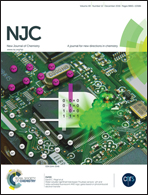A novel nano-sized binuclear nickel(ii) Schiff base complex as a precursor for NiO nanoparticles: synthesis, characterization, DFT study and antibacterial activity
Abstract
In the present contribution, a novel binuclear Ni(II) complex was synthesized from a hexadentate imine ligand (NNO)2 prepared via condensation of 9-hexyl-9H-carbazole-3,6-dicarbaldehyde and 2-amino-3,5-dibromobenzaldehyde and 5-bromo-2-hydroxyaniline using an ultrasonic method. The symmetric Schiff base ligand H2L = (C46H35Br6N2O2) and its nickel complex Ni2LCl2 were elucidated using different physicochemical methods including analytical analysis, magnetic moment measurement, FT-IR, 1H and 13C NMR, mass, UV/Vis spectroscopy, TGA and field emission scanning electron spectroscopy (FE-SEM). Nanoscale particles of nickel oxide were produced from the titled complex using a thermal decomposition method and analyzed using FT-IR, FE-SEM and X-ray powder diffraction (XRD) methods, which indicated close accordance to the standard pattern of NiO nanoparticles and showed an acceptable size in the nanorange (32 nm). Density functional theory calculations were carried out at the B3LYP levels of theory with a double basis set LANL2DZ for nickel, and a 6-31+G(d,p) basis set for the other atoms. The optimized geometry of the ligand and its nickel complex was obtained based on the optimized structures; the calculation of the FT-IR vibrational frequencies, 1H NMR and 13C NMR chemical shifts of the compounds were carried out and compared with those obtained experimentally. The results of this comparison demonstrated good agreement between the theoretical and experimental data, which can be strong evidence of the accuracy of the experimental analytical data and validity of the applied mathematical model. In vitro antimicrobial activities of the Schiff base ligand and its nickel complex were investigated against some Gram-positive (Staphylococcus aureus and Enterococcus faecalis) and Gram-negative bacteria (Pseudomonas aeruginosa and Escherichia coli) and compared with each other. It was found that the nickel complex showed higher activity.


 Please wait while we load your content...
Please wait while we load your content...